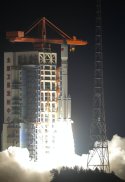The fins design is clear indication that it works very differently from SpaceX (both F9 and Superheavy booster) in recovery, e.g. using air dynamic break instead of rocket thrust to reduce speed when coming back.Inspections on the VTVL test vehicle found that it was in great working condition, with the fuselage, engine, tanks, and onboard electrical systems all functional as expected. The rocket was cleaned off and is now ready to be used again.





You are using an out of date browser. It may not display this or other websites correctly.
You should upgrade or use an alternative browser.
You should upgrade or use an alternative browser.
China's Space Program Thread II
- Thread starter Blitzo
- Start date
by78
General
ArrowHead/Space Epoch has successfully conducted its first VTVL test. The VTVL test vehicle is a stainless steel rocket with a diameter of 4.2m, a length of 26.8m, and a take-off mass of 57 tons. The test lasted 125 seconds, during which the vehicle reached an altitude of 2.5km before performing a soft splashdown landing in the water. The vehicle successively performed eight tasks: ignition and takeoff, full thrust climb, variable thrust adjustments, engine shutdown, free descent glide, engine restart, deceleration to hover on sea surface, and finally soft landing on the sea surface.



After the successful VTVL test, ArrowHead/Space Epoch plans to conduct an orbital launch recovery test later this year.

by78
General
That hosing picture took me out I would've thought they cleaned them with a bit more care
I mean it's almost as if a rocket specifically designed to land in the ocean and then be towed back to base would be able to withstand being hosed down.
I remember seeing these SpaceX's reuseable rockets that can move and latch itself back on the launch pad while landing.
Seeing the development of the VTVL rocket, I wonder if they could do what SpaceX did.
Seeing the development of the VTVL rocket, I wonder if they could do what SpaceX did.
The return to pad recovery has higher payload penalty therefor not preferred. Besides, return to pad is not more difficult to do than landing on a moving platform at sea. However return to pad does require boost back burn right after 1st stage separation. The Chinese design does not have that burn so it can not return to pad, but it is only because they want to maximize the payload, not because it is difficult.I remember seeing these SpaceX's reuseable rockets that can move and latch itself back on the launch pad while landing.
Seeing the development of the VTVL rocket, I wonder if they could do what SpaceX did.
escobar
Brigadier
Servicing mission may be underway. Joint Commercial Operations Cell report SJ-21 raised its average altitude to initiate a westward drift of 4 deg/day. At the time of the maneuver SJ-21 was at 133E and SJ-25 holding steady at 120E. If both satellites maintains current orbits they will be in proximity in the next 72hrs. Last time SJ-21 maneuvered, was in July 2023
The return to pad recovery has higher payload penalty therefor not preferred. Besides, return to pad is not more difficult to do than landing on a moving platform at sea. However return to pad does require boost back burn right after 1st stage separation. The Chinese design does not have that burn so it can not return to pad, but it is only because they want to maximize the payload, not because it is difficult.
I wonder if it is possible to have something like a oil rig platform placed downrange for recovery in the future
We have that, it's literally called drone ships. SpaceX uses this method of recovery for Falcon 9 while China is in the process of building one.I wonder if it is possible to have something like a oil rig platform placed downrange for recovery in the future
We have that, it's literally called drone ships. SpaceX uses this method of recovery for Falcon 9 while China is in the process of building one.
I'm aware of SpaceX drone ships. But they abandoned this idea after a few trials for some reasons, maybe related to stability of the ship idk, a stable platform should perform much better.
Edit: The platform can also use the proposed steel cable recovery method, imo this is actually superior to SpaceX's current solution
Last edited:

